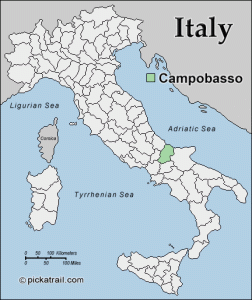Rome, the capital of Italy, is a popular tourist attraction with its inspiring art, architecture and culture on full display. The ancient ruins, including the Roman Forum and the Colosseum help visitors imagine a time long ago when the Roman Empire ruled. Rome gets about 30 million tourists per year, but there are so many parts of Italy that are beautiful and worth seeing.
Take a 3-hour drive southeast of Rome towards the Matise mountains and you will be entering Campobasso, the region of my ancestral home. To the northeast it is bordered by the Adriatic Sea, on the North by Abruzzo, to the southeast, Apulia, and Campania in the south. Here there is a mixed landscape with towns, cities and villages that run through hills and cliffs. Situated at an elevation of 2-thousand feet above sea level is a quaint little town called “Castropignano”. Due to its elevation it is often called the “Balcony Over The Biferno River Valley”. From the town you can see a beautiful panoramic view of the surrounding towns and hillsides. This is where the Madaleno family home is located.
Castropignano is a very small town with three interesting historical monuments: Evoli Castle, Church of San Salvatore, and Ruins of the Church of San Nicola.
Evoli Castle was built in 1362 by nobleman Giovanni d’Evoli. He was the founder of a large herding practice called “transhumance”. Transhumance is the practice of moving livestock from one grazing area to another in a seasonal cycle – normally to lowlands in winter and highlands in the summer. In 1636 Giambattista d’Evoli transformed the castle into a residential palace with elaborate works of art and furniture. Over the centuries transhumance and the society/culture associated with it declined. In the early 19th century the castle was stripped of everything and abandoned. Within a few decades it was in ruins; however, it’s charm and mystery remains a draw to this day.
For many centuries Castropignano has been known as an agricultural community, producing high quality wine, cheese and olive oil. When it comes to food, tradition is important here. Residents try to stay true to their roots when it comes to mealtime; using fresh ingredients and focusing on a lot of fruits and vegetables.
Family solidarity is everything in Castropignano. This is very different from our Canadian “nuclear family” mentality. In Castropignano extended family is extremely important so everyone is included, not just mom, dad, and the kids. This is one of the reasons any kind of celebration can become big. My late Nonno (grandfather), brought this tradition of family solidarity with him when he moved to Canada. Our gatherings at his house always included the whole family, as well as many friends, especially at mealtime.
Events are always big in Castropignano even though the town is small. Last year (2014), an old tradition was carried out in the streets of Castropignano to honour the institution of marriage. You can see in the link below how big the event became.
https://www.youtube.com/watch?v=TCupu4eMhnc
There are many small towns and villages across Italy that are worth noting, Castropignano is just one of them. If you are travelling this great country and find yourself in the Molise Region, visit this little town and take a step back in time.






